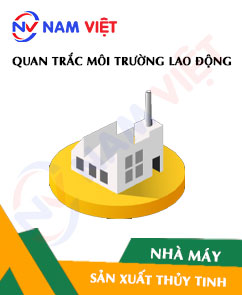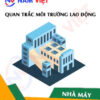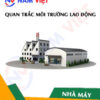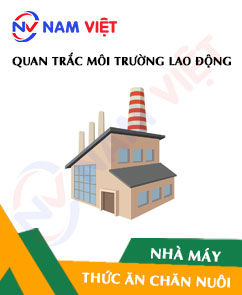Occupational environment monitoring at the factory producing glass
99,000 ₫
Note: The above price is calculated for one sample, the price may fluctuate depending on the area of the environment to be monitored and the movement of the market. For more accurate price support, please refer to the quotation table or contact directly with our consulting staff.
Environmental monitoring of glass manufacturing factories is a session of collecting, analyzing, and evaluating factors in the workplace that may be harmful to the health of workers.
Table of Contents
Toggle1. Overview of Glass Manufacturing Factories
a. What is a glass manufacturing factory?
A manufacturing factory for glass is a facility specialized in producing and processing glass. Glass is a non-metallic material produced from raw materials such as sand, soda, limestone, and additives. Glass manufacturing factories typically follow a primary processing procedure to create glass products such as bottles, cups, dishes, glasses, mirrors, and other glass items.

b. Production stages in glass manufacturing factories
The main production stages in a glass manufacturing factory include:
- Raw material preparation: Sand, soda, limestone, and other additives are prepared and mixed in specific ratios to create the glass mixture.
- Melting: The glass mixture is placed in a furnace at very high temperatures (1,400°C to 1,600°C) to melt into molten glass.
- Forming: The molten glass from the furnace is shaped into the desired product using methods such as:
- Molding: Molten glass is poured into molds with the desired shape and cooled to solidify into the glass product.
- Pressing: Molten glass is pressed through molds or onto surfaces to form products with specific shapes.
- Shaping and stretching: Molten glass is drawn into threads and stretched into glass products.
- Finishing: Once formed, glass products undergo finishing processes such as cutting, polishing, grinding, coloring, printing, or other steps to finalize the product.
- Quality inspection: Finished glass products are inspected to ensure compliance with quality standards. Inspection may include checking dimensions, transparency, strength, and other properties.
- Packing and transportation: Finished glass products are packaged and prepared for shipment to stores or end customers.

c. Machinery used in glass manufacturing factories
In glass manufacturing factories, various machines and equipment are used to perform production and finishing stages. Common machinery includes:
- Furnace: Heats raw materials to very high temperatures to melt them into molten glass.
- Molding machine: Used to pour molten glass into molds and create glass products with desired shapes.
- Glass pressing machine: Presses molten glass into products with the required shapes.
- Cutting and grinding machines: Used to cut and process formed glass products to achieve precise sizes and shapes.
- Coloring machine: Applies color or surface effects on glass products.
- Glass printing machine: Prints patterns, letters, or images onto glass surfaces.
- Quality inspection equipment: Includes devices for measuring dimensions, transparency, strength, and other properties to ensure product quality.
- Heat treatment system: Controls the cooling and solidification process of glass products.
- Waste treatment equipment: Handles waste and byproducts generated during production.

d. Occupational diseases for workers in glass manufacturing factories
Workers in glass manufacturing factories may be exposed to certain occupational diseases due to environmental hazards and work processes. Common occupational health risks include:
- Lung and respiratory diseases: Workers may inhale glass dust such as silica, lead compounds, lead oxides, and toxic gases, leading to pneumonia, pulmonary fibrosis, asthma, and other respiratory issues.
- Skin diseases: Prolonged exposure to chemicals in glass production can cause skin irritation, dermatitis, cracking, and eczema.
- Cardiovascular issues: The work environment may cause stress and work pressure, resulting in high blood pressure, chest pain, and heart diseases.
- Nervous system diseases: Exposure to toxic chemicals such as lead and mercury can harm the nervous system, causing memory loss, tremors, neurological damage, and mental disorders.
- Eye diseases: Workers may suffer from conjunctivitis, keratitis, and eye discomfort due to dust and irritants.
- Hearing issues: Noise and vibrations during production may damage hearing and cause ear-related problems.
To ensure worker safety, protective measures and safety systems should be implemented, including personal protective equipment, dust and waste control, occupational safety training, health monitoring, and compliance with safety and health regulations.

e. Common types of glass on the market
Various types of glass are widely used in industrial and consumer applications. Common types include:
- Crystal glass: Highly transparent, creating beautiful light reflection effects. Often used for decorations, jewelry, chandeliers, and other luxury items.
- Heat-resistant glass: Designed to withstand high temperatures, used in chemical, pharmaceutical, scientific, and high-temperature applications.
- Tempered glass: Reinforced through special heat treatment, making it stronger and more impact-resistant than regular glass. Used in windows, protective screens, mobile devices, and safety equipment.
- Chemically-resistant glass: Designed to resist corrosion and chemical impact, commonly used in medical, laboratory, chemical, and pharmaceutical industries.
- Casting glass: Shaped by hot or cold casting, producing special shapes like bottles, jars, dishes, and decorative items.
- Decorative glass: Used for decoration such as lamps, decor, watercolor glass, vases, and interior design items.
- Construction glass: Used in architecture and construction, including windows, glass walls, partitions, and other applications.
2. Overview of Occupational Environment Monitoring Services
a. What is occupational environment monitoring in glass manufacturing factories?
Occupational environment monitoring (workplace measurement) in glass manufacturing factories involves collecting, evaluating, and analyzing workplace environmental factors to implement timely measures, minimize health hazards, and prevent occupational diseases. It is a mandatory requirement for all glass manufacturing factories.
Monitoring plays a crucial role in protecting and improving workers’ health, as employees are the main resource directly generating profit for the company. Workers regularly exposed to occupational hazards beyond permissible limits may experience health problems and develop occupational diseases.
REGISTER FOR OCCUPATIONAL ENVIRONMENT MONITORING SERVICE
b. An Toan Nam Viet’s occupational environment monitoring program
An Toan Nam Viet’s occupational environment monitoring program is designed by monitoring engineers in occupational safety and environmental protection. Aiming to ensure worker health and safety, the program uses modern measurement techniques to monitor air quality, water, microclimate factors, physical conditions, and dust in the workplace. This program is essential for ensuring a safe working environment and protecting workers’ health.
Additionally, An Toan Nam Viet’s program plays an important role in researching and developing solutions to improve workplace environmental quality. With the expertise and professionalism of the monitoring team, this exclusive program represents a breakthrough in occupational safety and environmental management in Vietnam.

c. Standardization in occupational environment measurement procedures
Standardization in An Toan Nam Viet’s measurement procedures ensures accuracy and reliability. The program follows recognized standards from the Ho Chi Minh City Department of Health, ensuring that collected data is highly reliable for workplace environmental evaluation and decision-making.
Standardized procedures also guarantee measurements are performed by highly qualified monitoring specialists, enabling managers and experts to trust results and make accurate decisions for worker health and environmental protection.
By applying standardized procedures, An Toan Nam Viet demonstrates commitment to providing a safe working environment, protecting workers, and contributing to occupational safety and environmental management in Vietnam.
d. Reporting results of occupational environment monitoring in glass factories
Monitoring results are documented according to Form 04, Appendix III, Decree 44/2016/ND-CP, prepared in two copies: one for the contracting workplace and one retained by the monitoring organization.
Records must be kept indefinitely according to legal requirements.

e. Frequency of occupational environment monitoring according to the law
According to Clause 2 of Article 18 of the Law on Occupational Safety and Health 84/2015/QH13, employers must conduct occupational environment monitoring at least once per year.
f. Deadline for submitting monitoring reports according to the law
The deadline is before December 31 each year. Enterprises in manufacturing must submit reports to the local Department of Health where the factory and employees are located. When changes occur in technology, production, or facility upgrades that may introduce new hazards, enterprises must update occupational hygiene records accordingly.
g. Penalties for violations of occupational environment monitoring by employers
According to Article 27 of Decree No. 12/2022/ND-CP dated January 17, 2022:
- Clause 2: Fine of 2,000,000 – 5,000,000 VND for not publicly notifying employees of monitoring results immediately after they are available.
- Clause 3: Fine of 20,000,000 – 40,000,000 VND for not conducting occupational environment monitoring as required by law.
- Clause 4: Fine of 40,000,000 – 60,000,000 VND for collaborating with monitoring organizations to falsify results but not committing criminal offenses.
3. Harmful environmental factors for workers in glass production factories
Workers in glass production factories may be exposed to several harmful environmental factors. The following are potential factors that may pose risks to employees in the glass production industry:
- Glass dust: The glass production process can generate glass dust, and prolonged exposure to this dust can irritate the respiratory tract and cause respiratory problems, such as pneumonia, pulmonary fibrosis, and asthma.
- Chemicals: During glass production, chemicals such as silica, lead oxide, ammonia, sulfur compounds, and coloring agents may be used. Exposure to these chemicals can irritate the skin, eyes, and respiratory system and may cause damage to the body.
- High temperatures: Glass melting and processing require high temperatures. Workers must operate in high-temperature environments, which can cause discomfort and pose fire and explosion risks if safety measures are not followed.
- Noise: Machinery and production processes in glass factories generate high noise levels. Prolonged exposure to noise can harm hearing and cause psychological stress.
- Vibration: Some machinery and processes in glass factories generate vibrations. Prolonged exposure to vibration can cause musculoskeletal injuries, pain, and other health problems.
- Hazards from materials and tools: During glass production, workers handle sharp materials, cutting tools, and heated equipment. This creates risks of injuries, cuts, burns, and other accidents.
REGISTER FOR OCCUPATIONAL ENVIRONMENT MONITORING SERVICE
4. Measures to improve the working environment in glass production factories
Improving the working environment in glass factories is essential to protect workers’ health and safety. The following measures can be applied:
- Ventilation system: Ensure the factory has an efficient ventilation system to remove dust and toxic fumes from the glass production process. This reduces the risk of poisoning and respiratory irritation for workers.
- Use of protective equipment: Workers should be fully equipped and properly use personal protective equipment such as masks, gloves, goggles, and protective clothing. This protects them from direct contact with chemicals and glass dust.
- Occupational safety training: Conduct regular safety training to increase workers’ awareness and knowledge of hazards and protective measures. This helps them understand and comply with safety rules and prevent occupational diseases.
- Health monitoring: Conduct regular health check-ups to detect health issues related to toxic exposure early and adjust protective measures as needed.
- Waste management and recycling: Establish an effective waste management system to safely handle and dispose of waste from the glass production process and protect the environment. Encourage recycling and reuse of materials and recycled products to reduce production waste.
- Noise and vibration control: Implement measures to reduce noise and vibrations from machinery and production processes, including soundproofing, regular maintenance, and providing ear protection for workers.
- Safety with materials and tools: Ensure workers are trained in handling sharp materials and heated tools. Provide safety measures such as collision prevention and proper protective equipment.
- Periodically conduct occupational environment monitoring in factories to collect and analyze harmful factors affecting workers, and adjust to reduce risks to prevent occupational diseases.
5. Benefits of periodic monitoring in glass production factories
An Toan Nam Viet provides businesses with excellent benefits when using occupational environment monitoring services according to Decree 44/2016/ND-CP on managing and controlling harmful factors in the workplace affecting employees.
- Businesses can proactively control harmful factors in workshops or factories.
- Receive recommendations on measures to reduce harmful factors and improve workplace quality.
- Indirectly protect human resources, a key factor in business development.
- Reduce the harmful impact of occupational diseases on human health, lowering future treatment costs.
- Improve worker health, ensuring product quality and maintaining production output.
- Comply with labor safety laws and avoid legal risks.
- Enhance credibility and professionalism in all aspects, elevating the company brand.
Nam Viet’s environmental monitoring service is a solution to reduce occupational disease risks, contributing to a clean and high-quality working environment.

6. National occupational environment monitoring center
Occupational environment monitoring center of Nam Viet is a professional unit for supervising and measuring occupational environment quality throughout all provinces in Vietnam. With a team of experienced monitoring specialists, the center uses modern measurement equipment to ensure accuracy and reliability.
In addition to monitoring services, the center assists clients in planning, handling, and tracking workplace environmental issues. With the motto “customer-centered,” the center prioritizes customer satisfaction, meets all client needs, and commits to providing the best solutions for businesses.
REGISTER FOR OCCUPATIONAL ENVIRONMENT MONITORING SERVICE
With investments in technology, equipment, and human resources, Nam Viet’s monitoring center has become one of the most reputable units in occupational environment monitoring in Ho Chi Minh City, with the following objectives:
- We always value our brand reputation and service quality.
- We provide customers with the best and most suitable solutions possible.
- Alongside a team of experienced Masters and Engineers, committed to environmental protection and business benefit.
- At Nam Viet Environmental Monitoring, companies receive professional service from field experts and the best cost advantages.
The occupational environment monitoring process at Nam Viet includes the following basic steps:
- Before conducting monitoring, our company ensures all equipment is calibrated according to legal regulations.
- Follow the occupational environment monitoring procedures committed to the Department of Health accurately and fully.
- Report monitoring results honestly to employers.
- If monitoring results indicate unsafe conditions, Nam Viet provides corrective solutions, and the workplace implements the following:
- Implement measures to improve working conditions, minimize harmful factor impacts, and prevent occupational diseases.
- Conduct health examinations to detect occupational and related diseases early for workers in unsafe environments.
- Provide in-kind compensation to workers according to labor law.

7. Occupational environment monitoring quotation
To help businesses conduct professional and effective occupational environment monitoring, Nam Viet provides clients with a quotation for occupational environment monitoring services with quality and reasonable costs.
- Our quotation provides detailed pricing information for the monitoring services we offer, including costs related to travel, measurement, analysis, and reporting. Clients can trust the accuracy and reliability of the monitoring reports we provide.
- We commit to offering competitive and reasonable prices in the market and are always ready to provide quick and professional advice for any inquiries regarding monitoring services.
- With Nam Viet’s monitoring quotation, clients can easily select service packages suitable to their needs. We are committed to delivering the highest satisfaction with professional service quality.
No comments yet












Review Occupational environment monitoring at the factory producing glass
There are no reviews yet.